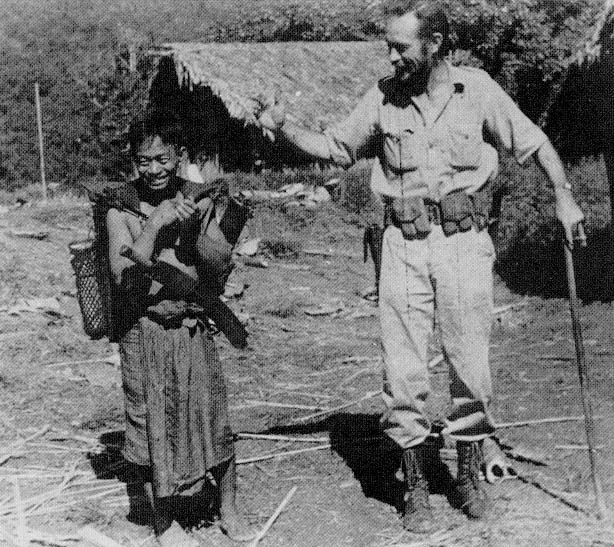Seventy-five years ago, this week, the forerunner for Special Forces was born.
During the dark days of World War II in April 1942, the OSS’ first operational detachment, 101 was activated. Detachment 101 was the first unit in U.S. military history created specifically for the purpose of conducting unconventional warfare operations behind enemy lines.
It was formed in April 1942, to perform espionage, sabotage, guerrilla warfare, propaganda, and escape-and-evasion operations in support of U.S. military objectives in China. The OSS was the forerunner of the US Army Special Forces and the CIA.
At war’s end, General Dwight D. Eisenhower wrote about Det. 101 in their award of a Presidential Distinguished Unit Citation that says in part, “The courage and fighting spirit displayed by its officers and men in offensive action against overwhelming enemy strength reflect the highest tradition of the armed forces of the United States,” signed Dwight D. Eisenhower, Chief of Staff, January 17, 1946.
Lt. General Joseph Stillwell was placed in charge of the China – Burma theater in January 1942 but had no American troops under his command. He commanded just Chinese forces and was, with the British, pushed out of Burma. He was sent a copy of the proposal to place the first OSS operational unit in his command, he welcomed them but not the commander that had been tasked. Stillwell suggested the OSS place CPT Carl Eifler in charge. It turned out to be a very smart decision.
Daunting Tasks Given Early: Three months after being activated, Detachment 101 arrived at the US headquarters in New Dehli, India. Stillwell said he wanted the officers and men of Detachment 101 to learn to survive and live in the jungles and to lead the way back into Burma. Stilwell wanted intelligence, as well as sabotage operations, aimed at reducing the effectiveness of the Japanese air base in Myitkyina, which had been a thorn for US planes flying “the Hump” into China.
Detachment 101 also had the follow-on orders to blow up road and railroad bridges leading to Myitkyina from the south. If that weren’t enough for the neophyte command, he tasked Detachment 101 to maintain liaison with the British so that the colonial government would have no complaint about Detachment 101’s activities.
By the end of 1942, Det.101 infiltrated its first group in Burma. Called A-Group, they blew up the railroad leading to Myitkyina in 30 places and dropped two spans of a bridge into the river. The American OSS had arrived.
Organizational Growth: Just a year later, the OSS had six intelligence gathering bases operating in Burma. They also had agent/radio operator teams scattered along the main transportation arteries leading to northern Burma. These teams communicated directly with the US base in India.
By early 1944 Det. 101’s guerilla force was expanded to 3000 men with the follow-on orders to expand to 10,000. By early 1945, Detachment 101’s guerilla force reached its peak at 10,800 men.
Detachment 101 provided 75 percent of the intelligence for which the 10th Air Force chose its missions and 85 percent of the intelligence for Stillwell’s Command.
Detachment 101 sabotage agents and guerrillas demolished 57 bridges, derailed nine trains, destroyed, or captured 272 trucks or other vehicles, and destroyed 15,000 tons of Japanese supplies. These sabotage operations also had the effect of forcing the Japanese to deploy additional troops to protect their supply chain and lines of communication.
Detachment 101’s greatest effectiveness was in the new, cutting edge field of guerrilla warfare. The unit’s members pioneered the use of air and radio communications to support and coordinate guerrilla warfare activities. They recruited, organized, trained, equipped, and led more than 10,800 guerrillas in effective support of conventional military operations. Detachment 101’s guerrilla forces killed 5,428 members of the Japanese army, wounded and estimated 10,000, and captured 78 Japanese prisoners. Their own losses were 27 Americans, 338 native guerrillas, and 40 espionage agents killed.
The OSS and Detachment 101 were the prototype for the modern-day Special Forces and the Special Operations Command of the military. They learned the hard lessons by trial and error which in combat were expensive with a well-trained, determined enemy.
The unit grew from conducting small-scale sabotage operations to a well-disciplined, professionally run unit conducting large guerrilla operations behind the Japanese lines. Many of the officers who served in the OSS in World War II were instrumental in forming the new US Army Special Forces groups. Others joined the fledgling CIA and became the backbone of the US’ clandestine intelligence service.
Photo courtesy of US Army
This article is courtesy of SpecialOperations.com










COMMENTS
You must become a subscriber or login to view or post comments on this article.